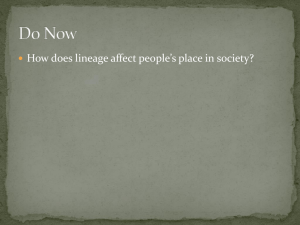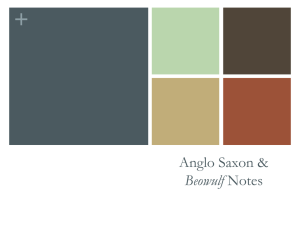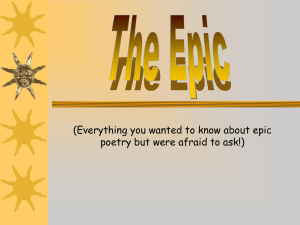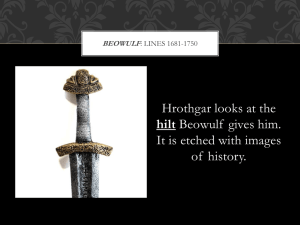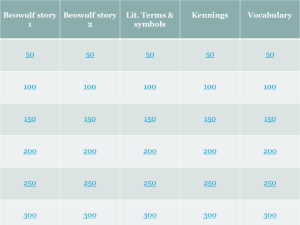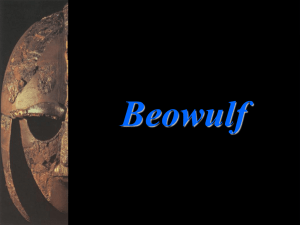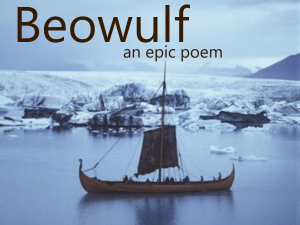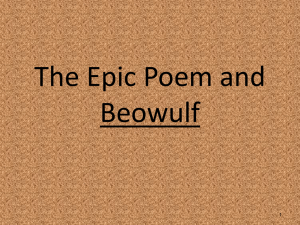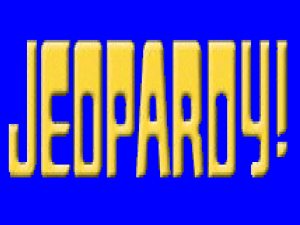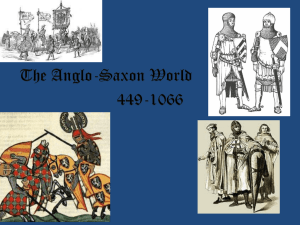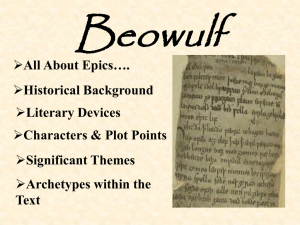Beowulf Background
advertisement
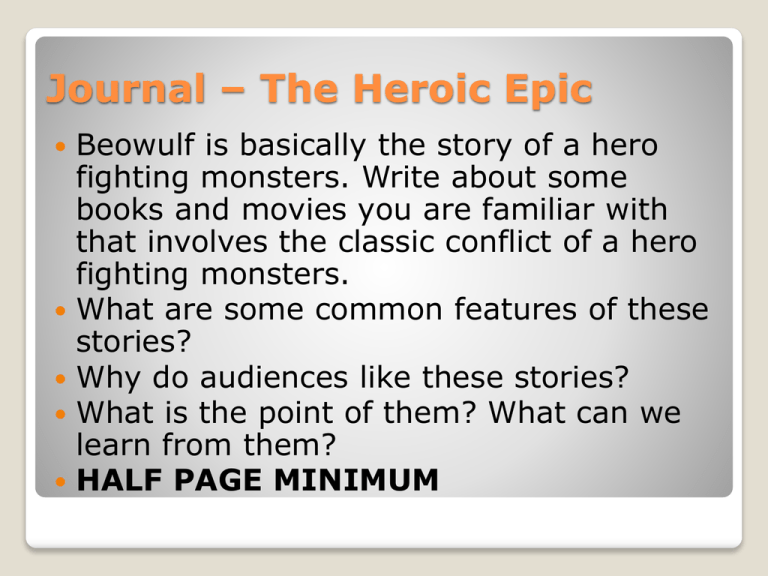
Journal – The Heroic Epic Beowulf is basically the story of a hero fighting monsters. Write about some books and movies you are familiar with that involves the classic conflict of a hero fighting monsters. What are some common features of these stories? Why do audiences like these stories? What is the point of them? What can we learn from them? HALF PAGE MINIMUM Beowulf BACKGROUND NOTES Background Notes The Epic Tradition An epic is ◦ a long narrative poem that relates the great deeds of a larger-than-life hero who embodies the values of a particular society. ◦ a quest story on a grand scale. ◦ mixture of myth, legend, folklore, and history. ◦ serious in tone and grand in it’s language. Beowulf and the Epic Tradition The Greeks The Iliad & The Odyssey The AngloSaxons Beowulf 15,000 lines 3200 lines 720-680 BC 700-750 AD Athens Northumbria Greek Old English The Epic Tradition It is the Beowulf first great Anglo-Saxon work. is part of the oral tradition, passed down by mouth, with changes and embellishments, from one bard (called a scop) to another. It was told to people who crowded around the bards in the communal halls (mead halls) at night. AngloSaxon society was based around these mead halls. Mead is honey wine. People would gather in mead halls to imbibe and listen to stories from the bards. Mead Hall Beowulf Plot Summary Beowulf, whose name may mean “bear,” is a Geat from Sweden who crosses the sea to Denmark in a quest to rescue King Hrothgar from the demonic monster Grendel. STORY ELEMENTS ◦ dream/legend (Celtic and Scandinavian) ◦ monsters ◦ god-fashioned weapons ◦ descends to the underworld ◦ fights with dragons ◦ the hero’s quest ◦ a community threatened by evil ◦ mixture of Pagan and Christian values ◦ the Anglo-Saxons were fatalistic, they believed your fate was already determined ◦ Beowulf boasts about his accomplishments (an Anglo-Saxon value) The Epic Hero ◦has superior physical strength. ◦is supremely ethical. ◦during his quest, must defeat monsters that embody dark destructive powers. ◦at the end of his quest, is glorified by the people he has saved. Christian vs. Pagan Christian elements in Beowulf exist sideby-side with pagan (in this case, Norse religion) elements. The story, passed many generations from bard to bard, was probably finally written down by a Christian monk The only manuscript we have of Beowulf dates back to 1000 AD and is in the British Museum in London. Burned and stained, it was discovered in the 18th century, surviving Henry VIII’s destruction of the monasteries 200 years earlier. Characters Beowulf: The protagonist of the epic and a member of the Geats (Swedish tribe). He comes to king Hrothgar’s Danish tribe to help them against the monster Grendel. Edgetho: Beowulf’s father. Higlac: king of the Geats and Beowulf’s uncle. Brecca: chief of the Brondings, a tribe, and Beowulf’s friend Characters Herot (place): the golden mead-hall built by King Hrothgar, the Danish ruler. It was decorated with the antlers of stags; the name means “hart [stag] hall.” Hrothgar: king of the Danes, builder of Herot. He had once befriended Beowulf’s father Edgetho. His father was called Healfdane (“half Dane”). Hrothgar’s name might mean “glory spear” or “spear of triumph.” Characters Unferth: one of Hrothgar’s courtiers, reputed to be a skilled warrior. Initially antagonizes Beowulf. His sword, Hrunting, is used by Beowulf in a later battle. Welthow: Hrothgar’s wife, queen of the Danes. Wiglaf: a Geat warrior, one of Beowulf’s select band, and the only one to help him in his final fight with the dragon. Wiglaf might be related to Beowulf. The MONSTERS Grendel: man-eating monster who lives at the bottom of a foul mere, or mountain lake. He attacks Herot, and Beowulf comes to Herot to slay him. His name might be related to the Old Norse grindill, meaning “storm,” or grenja, “to bellow.” Grendel’s Mother: Attacks Herot in vengeance over her son’s death. The Dragon: A dragon that rampages the countryside 50 years after the fight with Grendel’s Mother until Beowulf defeats it. Journal – Heroes and Monsters What do heroes symbolize in literature? Who is your favorite (fictional) hero and why? Who is a real life hero you revere? Do they share any common attributes? What monster do you find most frightening? Why? What are the attributes of a monster? What do monsters symbolize? https://www.youtube.com/watch?v=Y13c ES7MMd8 Beowulf Read in Old English https://www.youtube.com/watch?v=AJ_N 3XH3ntI Beowulf The Movie

